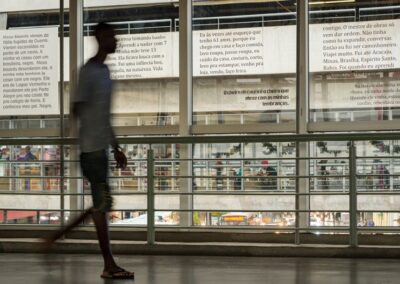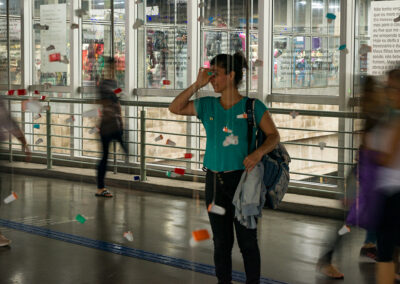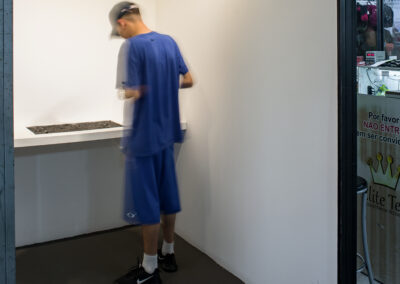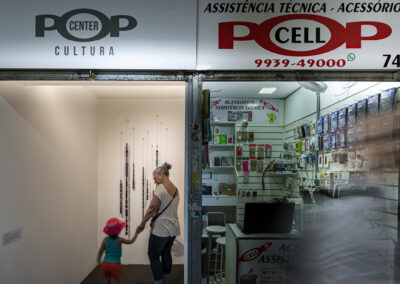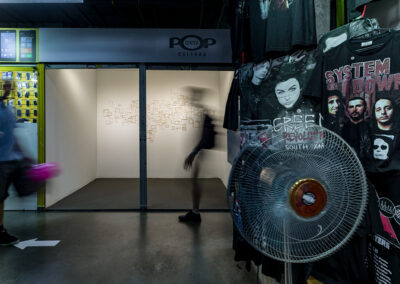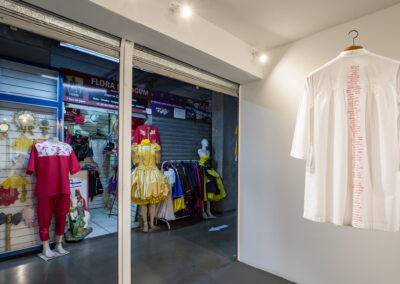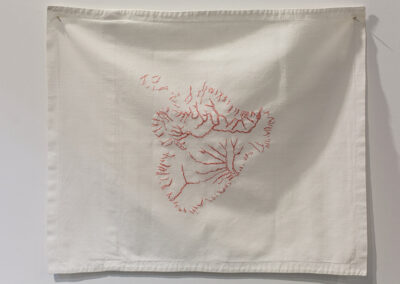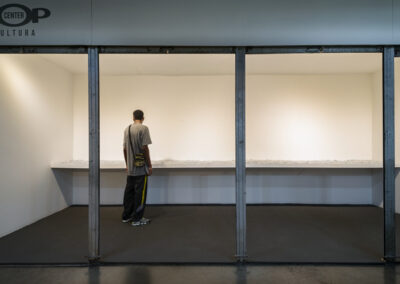Visionários | 2018
2ª Residência Artística Pop Center, Porto Alegre, Brasil
Curator: Franck-James Marlot
Description of works

1 - We Are a Story | 2018
As early as my first contact with the Pop Center shop owners, I realized the power of their stories – accounts that speak to us of the intense migration that took place throughout Brazil over the last fifty years in search of better living conditions.
Thus, along eighty meters of glass windows – that make up a large aquarium which projects us over the busy Avenida Júlio de Castilho – I distributed fragments of the life stories generously entrusted to me by those shop owners who engaged in my artistic residency project.
- white, gray and frosted self-adhesive film
- access the work page here
Photo: Claudio Stein

2 – Visionaries, Pop Center | 2018
The idea of working with the history of most – albeit not exclusively – gaúcho shop owners and their amazing life stories emerged at the very start of the Pop Center artistic residency. Enriched by the photographic record of various individuals and their wanderings throughout the four corners of Brazil’s southern region until their arrival in Porto Alegre, publication of the work Visionários [Visionaries]/2002 was a logical consequence.
- 400 plastic slide viewers and colored photographs
- variable dimensions
- access the work page here
Photo: Claudio Stein

4 - Black gold | 2015
A few fragments leftover from the process of covering old documents with successive layers of graphite stick–small sculptures created by chance through handling.
- handmade graphite stick and industrial graphite dust
- 28 x 56 x 5 cm
- EXHIBITIONS: 'Inventory of oblivion’, Galeria Inox, Rio de Janeiro, Brasil
- access the work page here

4 - Cumuliform blues | 2016
Looking at what was stored in the houses, inside the drawers, I came across sewing materials. In this work, I chose to work with buttons by collecting and classifying them: each of the sets of buttons belonged to a woman who kept them for her entire lifetime, imagining a day when she might recycle them, sewn onto a new frock.
-
- buttons, cotton thread, nylon coated stainless steel cable
- variable dimensions
- access the work page here

5 - There is no photograph without something or someone | 2015
In handling the images of a photograph collection, gathering images of people I don’t know and who shall remain anonymous, I focused my gaze upon their margins, and various outlines, hues and formats, as if wanting to simply retain their aura.
- photographic paper
- series, three formats: 80 x 140 cm, 85 x 85 cm, 50 x 40 cm, with option of presentation in situ, in variable dimensions com opção de apresentação in situ, em dimensões variáveis
- access the work page here

6 - Tanya, Ton silence | 2004
Onto a white smock of the kind they wore in perfoming their work, I embroidered a list of names of domestic servants with whom I shared intimacy and affection during various periods in my life; in this work, I sometimes remembered nothing beyond a name, a fact or just a face, until the women reappeared fully and completely to my mind.
- embroidery on cotton smock
- 50 x 150 cm
- EXHIBITIONS: 'Eu / outro / eu’, Galeria de Arte da Uerj, Rio de Janeiro, Brasil
- access the work page here

7 - Heart | 2004
I came across these waterways in an old book of maps; they appear to have been drafted in the seventeenth century. Embroidered onto an old pillow case, the maps reveal a resemblance between the South American continent and the hollow muscular organ at the center of our circulatory system.
- cotton pillow case
- 43 x 54 cm
- access the work page here

8 - Remembrance and Oblivion | 2005
I recorded and dispersed printed memories and recollections of an imaginary journey onto countless strips of crystal paper that occupy the entire space. It is not the reading of each one of the many written phases that matters –repeated possibly one thousand times – but the idea of how much memory and flaw exist within us.
- ink jet print on handcut crystal paper
- variable dimensions
- EXHIBITIONS: ‘Déplacements’, Le Showroom, Paris, França / ‘Sangue novo’, Museu Bispo do Rosário, Rio de Janeiro, Brazil
- access the work page here
Fotografia: Fabio Del Re
TEXT
VISIONÁRIOS
Franck-James Marlot
Pop Center, 2018
Above one of the two overpasses that span the Pop Center, a cloud of four hundred plastic slide viewers is suspended above the ground, occupying the vast exhibition space.
Their grouping intrigues the spectator, inviting him to open his eyes to scrutinize and observe images that may be seen by peering through the monocles that hang at different heights.
The spectator is afforded an intimate gaze at a set of photographs collected by artist Renato Bezerra de Mello from store owners who participated in the creation of an image bank of their professional and family lives.
This affectively rich corpus of images functions as a snapshot that reactivates a considerable part of the city of Porto Alegre’s history, arriving at the banks of the Jacuí River and, occasionally, extending to Brazil’s very border.
Because one cannot see all of the images simultaneously, it becomes the task of the spectator’s visual memory to collect those instants. Given that no one can see all the images, each view remains partial and unique, since some of the plastic viewers are inaccessible to any eye as a result of the extreme height at which they hang.
Renato had already presented this installation in 2002, in Paris, and later in Recife and São Paulo. Whereas, this time around, the piece encompasses the memories of the store owners who took part in the project, the one before it blended functional and fictional memories to the artist’s own as he presented portraits of members of his family alone. By virtue of its global architecture and its individual reading, this installation heralds the planetary web of social networks and the cybernaut behind the computer window.
As an extension of the Visionários [Visionaries] installation and above the two overpasses, Renato presents a second piece titled A gente é uma História [We Are a Story]; this one makes use of shop owners speaking.
For three days, he collected their stories about events that had marked them in terms of how they express the hardships of life or, alternately, introduced moments of happiness.
Following the extension of the Pop Center’s pathway, the artist has covered the glass along the overpasses with one hundred quotations from his interviews. Through the glass, the incessant flow of cars creates a visual contrast to the letters, to the words, to the phrases that inscribe themselves, frozen, in the transparency of the glass wall. Here, the collective memory of the shop owners is scarified in glass and offered up in subtle shards that suggest intense lives.
In the street, the letters inverted in the mirror are reflected like an echo towards the city. Pop Center is a place of work and trade for the citizens of Porto Alegre, but it is first and foremost a place of welcome and of humanity. The artist is a mediator of those voices and it is he who allows us access to this privileged encounter.
Side by side, these two installations extend like eyes and a mouth to make up a single face, the face of the Pop Center’s men and women that are the history of the [Brazilian state of] Rio Grande do Sul.
Both the first installation (Visionários) [Visionaries] and the second, A gente é uma História [We Are a Story], bring us the shop owners’ memories. Through the plastic device, this collective memory is fragmented to better evoke the intensity of these lives that through writings and images remain present and cannot be erased.
For this second edition of the Pop Residency, guest artist Renato Bezerra de Mello chose to enrich our view of his work by inviting us to move through six vacant, untenanted Pop Center stores painted museum white for the occasion.
The artist presents works that call up the labors of writing and of drawing through his use of carbon paper, crystal, fabric, buttons, and graphite. By introducing the reliquaries of one work into another, the artist imbues the process with the meaning of a thread that unwinds from work to work, as evidence of something to which only the artist possesses the keys.
